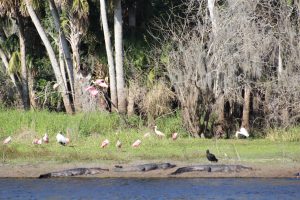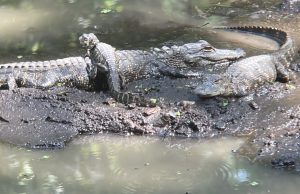
Unlikely team player
While many reptiles get a bad rap for being “cold-blooded”, just like all species of wildlife, they too are part of an interconnected web of life and play an important role on nature’s team. Have you ever visited a wetland habitat and wondered how the birds that you enjoy viewing coexist with alligators living and basking so close to them? Well, according to research findings from the University of Florida, at times, both birds and alligators benefit from this seemingly precarious positioning (James, 2016).
Raccoons are voracious predators of the eggs of many wildlife species, from sea turtles to snakes and birds. As capable and agile climbers, raccoons can access bird eggs even in the tops of trees. When wading birds like the great egret nest in areas where alligators are present, those alligators are a deterrent to raccoons, protecting the eggs of wading birds from predation (James, 2016). Acting as natural bodyguards, those alligators receive a little pay for their efforts too! Naturally, not all chicks that hatch will survive, and those that do not make it fall into the water and provide a significant source of nourishment for female alligators, just weeks before they begin to lay their own eggs (James, 2016). Read more about these fascinating findings here.

Ecosystem engineers
In Florida, seasonally fluctuating water levels impact organisms from all walks of life- including humans. In the Everglades, alligators play a key role in shaping or “engineering” the ecosystem by burrowing or wallowing in the mud, which creates what are called alligator holes. Alligator holes are depressions in the ground where water pools and remains, even in the dry season. They provide critical habitat and feeding grounds for wildlife such as fish, birds, amphibians, and more, when water levels elsewhere are low.
Helpful indicator species
Alligators are apex predators in the ecosystems within which they live. As apex predators, they help control the populations of other wildlife, and can even consume invasive species. Because of apex predators’ important roles and impacts in their ecosystem, their presence, individual health, and population size can often be used by scientists and conservationists to study and understand the health of the ecosystems within which they live, as well as the impacts of human activity on those ecosystems.

Gratitude for a Florida icon
What would Florida be without the over 1 million alligators that call it home? These fascinating, powerful, and resilient reptiles captivate both visitors and residents alike, and provide vital ecosystem services for Florida’s unique and beautiful freshwater habitats.
For more information about the biology and ecology of the American alligator, as well as how to recognize normal versus aggressive alligator behavior and stay safe, check out our free, Wild Sarasota webinar all about the American alligator!
See you next week for another story of gratitude! Find more blogs in the Stories of Gratitude for the World of Wildlife series here.
Resources
- Harvey, R. G., Mazzotti, F. J., & Brandt, L. A. (2021). The American Alligator: An Indicator Species for Everglades Restoration. EDIS. edis.ifas.ufl.edu/publication/UW358
- James, B. (2016, March 1). Birds and Gators Help Each Other in Florida’s Wetlands. University of Florida News. news.ufl.edu/articles/2016/03/birds-and-gators-help-each-other-in-floridas-wetlands.html
 1
1
